European Beer Bloggers Conference 2012
ABV: 7.4%, 9.2% and 10.5%
Origin: Huddersfield, Kirklees, England
Website: www.magicrockbrewing.com
The last few years have seen not just the relentless growth of microbrewing in the UK but also the emergence of new approaches that challenge the old business model of the traditional cask ale market. A broad movement is emerging that cultivates an image and approach more attuned to the tastes of the growing numbers of younger drinkers developing an interest in specialist beer, and is much more open to international influences – particularly from the US in terms of both the beers themselves and the way they’re marketed. Some people tag the representatives of this trend as “craft breweries” and though I think this is an unhelpfully narrow use of the term (see why here), I know what they mean when they say it.
Magic Rock has rapidly established a place for itself in the forefront of this new wave in little over a year. It was founded in March 2011 by businessmen and beer lovers Richard and Jonny Burhouse, the former with previous form in the specialist beer world through his involvement with online retailer myBrewerytap.com. They brought in brewer Stuart Ross from the Crown brewery in Sheffield brewpub the Hillsborough Hotel, whose CV also includes a stint at Kelham Island – thereby placing Magic Rock among the branches of that intertwined family tree that links back to the influence of brewer, licensee and British beer legend Dave Wickett, who died earlier this year.
From the start the men behind Magic Rock were upfront about their transatlantic aspirations. “The intention is to brew modern flavour-forward beers inspired in part by US craft breweries,” said Rich early in 2011. In this they’re not alone but they’ve certainly caught the style more accurately than most British brewers and managed to bring in their own character too.
I was struck by this when the brewery sent me some sample bottles last autumn, nicely presented in 330ml size and labelled with very distinctive and elaborate pen drawings depicting the brewery’s chosen circus themes. I particularly singled out Cannonball as a well balanced example of a contemporary US-influenced India Pale Ale. It’s brewed with pale, pale crystal and Vienna malts and a trio of US hops – Centennial and Columbus in the boil, Citra in the hop back and more Centennial as a dry hop during conditioning.
It’s a deep gold beer with an off-white creamy head and a creamy and spicy but rounded hop aroma. Estery notes indicate something of its 7.4% ABV, and there’s also a hint of ginger in the nose. The palate is packed with bitter marmalade, pine and almonds, warming into a peach fruit finish with a very light touch of roast in the flavour. The hops leave an assertively resinous, slightly vegetal slick but are nicely rounded by the fruit.
Following this promising encounter I seized the opportunity to visit the brewery during the European Beer Bloggers Conference in May 2012. Arriving at the rather plain industrial buildings in an unexceptional suburb of Huddersfield, the origin of the brewery’s name is immediately obvious – it adjoins the Burhouses’ existing family business trading in crystals, gemstones and decorative rocks. Bins in the yard at the front sparkle with polished pebbles and crystals in a rainbow of colours, destined for home and business decoration, jewellery and new age vibe channelling.
Inside, spread across two floors, is a fairly standard brewhouse from Malrex of Burton upon Trent, originally around 20hl (12 barrels) although the size of the vessels has since been increased to accommodate 26hl (16 barrels). Fermentation capacity has also multiplied since opening, with several outdoor cylindroconical tanks now supplementing the original pair of indoor ones.
The main grist suppliers are Yorkshire maltsters Fawcett, supplemented by speciality producers Weyermann in Franconia. The brewery runs a single infusion mash, using hop pellets in the boil and whole hops in the hop back – an important stage in achieving the desired hoppy character. Yeast is mainly a Californian strain originally obtained in dried form and related to the yeast used at Sierra Nevada, but they also use an ale yeast supplied by Thornbridge. The same tanks are used for fermentation and conditioning, with the latter now lasting for a month on most beers, including a week of dry hopping in tank.
About 90% of the beer goes out in cask. At the moment bottling volumes are small but are likely to grow – the beer is now being bottled at Camden Town brewery in London from bulk supplies. Bottled beer is rough filtered and unpasteurised, but as there’s no intention for it to continue to ferment, it’s not strictly speaking bottle conditioned.
Another growing area is keg or, more precisely, keykeg – the new “bag in a ball” system increasingly favoured by small craft breweries worldwide. The beer is placed in a disposable sterile bag inside a reusable PET container which is itself housed in a distinctive octagonal cardboard carton. It’s dispensed by pressurising the space between the bag and the outer container with air or CO2, literally squeezing the beer out, with no extraneous air or gas coming into contact with the beer itself.
Keykeg beer isn’t intended to referment in the container like traditional cask, but at Magic Rock and many other craft breweries it’s not pasteurised or artificially carbonated either. Instead it’s brewery conditioned with its natural sparkle sealed in the keg, giving a livelier beer than is typical for cask.
The interest in this format in the UK is increasing significantly – previously only one keg at Magic Rock might have been filled from a single brew, but now it’s closer to ten. Keykeg is also suitable for export, whereas the skills and equipment for handling cask are virtually unknown outside Britain. At present Magic Rock exports on a small scale to Norway but hopes to expand. “We expect the demand for keg is going to be massive in future,” predicts Stuart.
The sampling taps at the brewery only dispense keykeg beers and very good they are too. One of the highlights was Human Cannonball, the big brother of Cannonball, boosted not only with extra alcohol but with a whopping 25kg of hops in the hop back for every 20hl brew. This rich amber beer hits you with an aroma of lemon squash, melon and hay, with stewed hops so vivid you can almost see them steaming in the hop back. There’s a firm malty body with more melon fruit and obvious, though rounded, alcohol. Spicy pepper, pine and chilli-like notes dance on a warming finish, leaving a burry bitter slick that takes minutes to fade.
You’d expect a brewery like this to offer an imperial stout and they don’t disappoint with Bearded Lady, a development of a more approachable 6% stout called Dark Arts. I sampled it on keg at the Port Street Beer House in Manchester back in January, discovering a complex beer with a near-black colour, chocolate, carbon and some cakey malt on the aroma.
This too had a notably hoppy palate – with 10kg of hops in the hop back per brew, it’s some way behind Human Cannonball in the hop monster league, but the resinous cones made their presence felt alongside roast, minerals and tangy fruit. Overall, though, these vivid flavours were well integrated within a smooth and milky mouthfeel with not too much sweetness. The finish turned immediately tangy to the point of slight astringency, with emerging ashy flavours and fine dark chocolate.
Given the pervasive US influences, barrel ageing is a logical next step and sure enough Magic Rock is already experimenting, having acquired four refill barrels of various kinds. The first result is a version of Bearded Lady aged for six months in a former bourbon barrel and called, naturally enough, Bourbon Barrel Bearded Lady. This was eagerly anticipated during the beer bloggers’ visit, and a communal cry of anguish went up when it appeared the beer had run out after only a handful of glasses, followed by an even bigger sigh of relief when it turned out only to be a dispensing problem that was soon solved.
This thick black beer had a spirity, brown sugar aroma with notes of sherry fruit cake and a sharpish black cherry yoghurt-like touch. A tingly, minty palate boated richly fruity, raisiny malt, followed by a massive development of chocolate flavour teased by Listerine-like phenols. The very long and toasty dry chocolate finish had shards of hops with generous sweetness and developing roast coffee character, with more raisin fruit – an impressive example of the style.
One criticism that could be levelled at Magic Rock is that they are just a little too slavish in their apeing of the US craft brewing model, but the desire to experiment opens up the opportunity to create beers in a really distinctive style, and there’s a Yorkshire groundedness about the operation that should help too. Definitely one to watch.



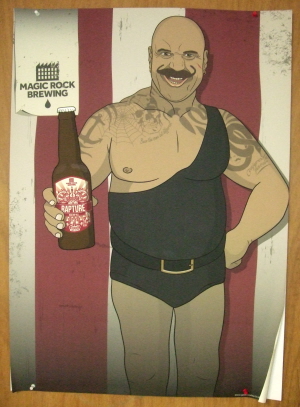
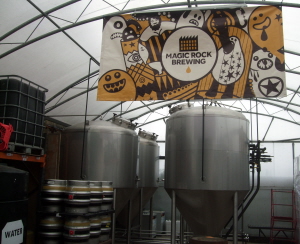
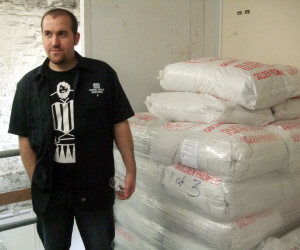

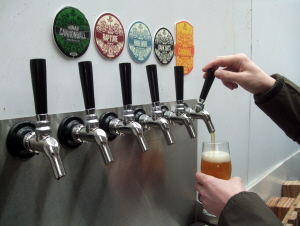
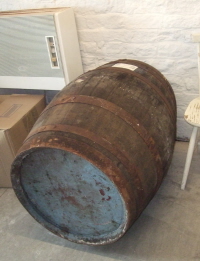
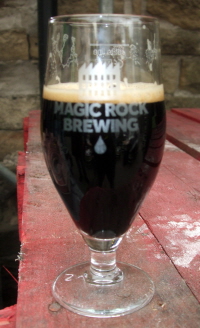


By-eck this stirs some cracking memories Des, I can almost taste that Bourbon barrel aged Bearded Lady now, deeeeelish!
Sadly it is only nearly, making do with Yorkshire tea instead. Cacking, informative review.
Cheers
Have you tried the clown juice yet Des? Great strong wit